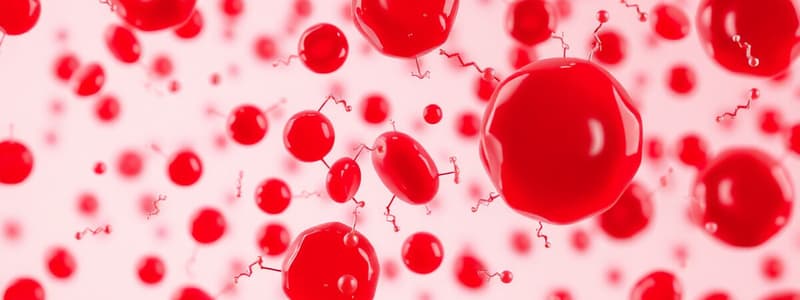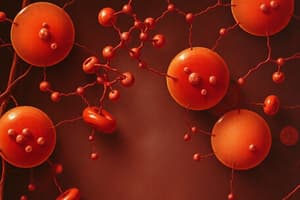Podcast
Questions and Answers
Which of the following are types of white blood cells (WBC)?
Which of the following are types of white blood cells (WBC)?
- Neutrophils
- Eosinophils
- Basophils
- All of the above (correct)
What process produces formed elements in the blood?
What process produces formed elements in the blood?
Hematopoiesis
Hematopoiesis occurs only in the red bone marrow after birth.
Hematopoiesis occurs only in the red bone marrow after birth.
False (B)
What is the normal pH range of the body?
What is the normal pH range of the body?
What are the three types of plasma proteins?
What are the three types of plasma proteins?
The most abundant type of plasma protein is ______.
The most abundant type of plasma protein is ______.
Erythrocytes are also known as white blood cells.
Erythrocytes are also known as white blood cells.
What is the shape of a red blood cell (RBC)?
What is the shape of a red blood cell (RBC)?
Match the following components of blood to their descriptions:
Match the following components of blood to their descriptions:
What is the primary function of hemoglobin?
What is the primary function of hemoglobin?
Flashcards are hidden until you start studying
Study Notes
Blood
- Transports gases, nutrients, and waste products
- Transports processed molecules
- Regulates pH and osmosis
- Maintains body temperature
- Protects against foreign substances
- Aids in clot formation
- Transports oxygen
- Normal pH of the body is 7.35 - 7.45
- Contains heme and globin
Plasma
- 55% of total blood
- Pale, yellow liquid that surrounds cells
- 91% water, 7% proteins, 2% other substances
Plasma Proteins
- Albumin:
- Maintains water balance
- 58% of plasma proteins
- Most abundant type
- Low levels may cause edema
- Globulins:
- Aid in the immune system
- 38% of plasma proteins
- Fibrinogen:
- Aids in clot formation
- 4% plasma proteins
Formed Elements
- 45% of total blood
- Consists of cells and cell fragments
- Erythrocytes (Red Blood Cells)
- Disk shape with thick edges
- Lack a nucleus during development (anucleus)
- Live for 90 - 120 days
- Transport oxygen to tissues
- Lack of organelles
- Contain hemoglobin
- **Leukocytes (White Blood Cells)
- Neutrophils
- Eosinophils
- Basophils
- Monocytes
- Lymphocytes
- Thrombocytes (Platelets)
Hemoglobin
- Carries oxygen
- Contains one iron atom
- Oxyhemoglobin:
- Hemoglobin with an attached oxygen molecule
- Globin protein:
- Attached to a heme molecule
- Chemical symbol of iron: Fe+
- Iron:
- Found at the center of hemoglobin
Hematopoiesis
- Process that produces formed elements
- In fetuses, hematopoiesis occurs in:
- Liver
- Thymus
- Spleen
- Lymph nodes
- Red bone marrow
- After birth, hematopoiesis primarily occurs in red bone marrow
- In adults, formation occurs mostly in bone marrow, but some WBCs are produced in lymphatic tissues
Hemocytoblast
- Stem cells
- Blood cells are derived from a single population of these cells
Erythrocyte Production
- Decreased blood oxygen levels cause the kidneys to increase production of erythropoietin
- Erythropoietin stimulates the production of RBCs
Erythrocyte Breakdown
- Break down into amino acids
- Heme group breakdown is converted to biliverdin
- Biliverdin converted to bilirubin
- Bilirubin is excreted by the liver into the intestines
- Small quantities of bilirubin are also excreted in the urine and feces
- This is why urine has a yellow color (due to urobilin).
Studying That Suits You
Use AI to generate personalized quizzes and flashcards to suit your learning preferences.




